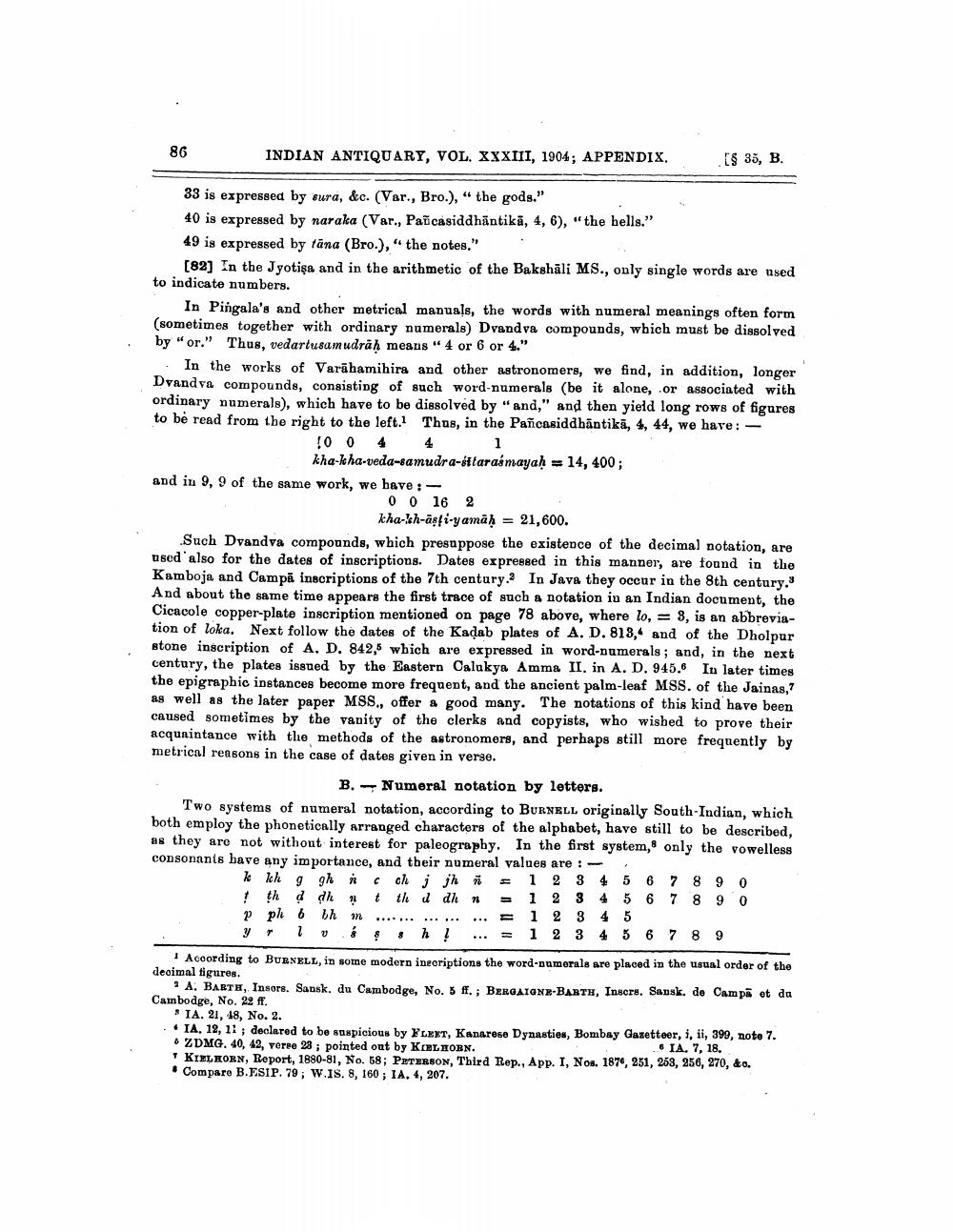________________
86
INDIAN ANTIQUARY, VOL. XXXIII, 1904; APPENDIX.
33 is expressed by sura, &c. (Var., Bro.), "the gods."
40 is expressed by naraka (Var., Pañcasiddhantikā, 4, 6), "the hells."
49 is expressed by täna (Bro.)," the notes."
[82] In the Jyotisa and in the arithmetic of the Bakshali MS., only single words are used to indicate numbers.
In Pingala's and other metrical manuals, the words with numeral meanings often form (sometimes together with ordinary numerals) Dvandva compounds, which must be dissolved by "or." Thus, vedartusamudraḥ means "4 or 6 or 4."
In the works of Varahamihira and other astronomers, we find, in addition, longer Dvandva compounds, consisting of such word-numerals (be it alone, or associated with ordinary numerals), which have to be dissolved by "and," and then yield long rows of figures to be read from the right to the left. Thus, in the Pañcasiddhantikā, 4, 44, we have: - 10 0 4
1
4
kha-kha-veda-samudra-sttaraśmayaḥ = 14, 400;
and in 9, 9 of the same work, we have :
[§ 35, B.
0 0 16 2 kha-sh-asfi-yamaḥ
= 21,600.
Such Dvandva compounds, which presuppose the existence of the decimal notation, are used also for the dates of inscriptions. Dates expressed in this manner, are found in the Kamboja and Campa inscriptions of the 7th century. In Java they occur in the 8th century." And about the same time appears the first trace of such a notation in an Indian document, the Cicacole copper-plate inscription mentioned on page 78 above, where lo, = 3, is an abbreviation of loka. Next follow the dates of the Kadab plates of A. D. 813, and of the Dholpur stone inscription of A. D. 842,5 which are expressed in word-numerals; and, in the next century, the plates issued by the Eastern Calukya Amma II. in A. D. 945.6 In later times the epigraphic instances become more frequent, and the ancient palm-leaf MSS. of the Jainas,7 as well as the later paper MSS., offer a good many. The notations of this kind have been caused sometimes by the vanity of the clerks and copyists, who wished to prove their acquaintance with the methods of the astronomers, and perhaps still more frequently by metrical reasons in the case of dates given in verse.
"
B. Numeral notation by letters.
Two systems of numeral notation, according to BURNELL originally South-Indian, which both employ the phonetically arranged characters of the alphabet, have still to be described, as they are not without interest for paleography. In the first system, only the vowelless consonants have any importance, and their numeral values are:
k kh g gh n C oh j jh n t th d dh nt th d dh n p ph b bh m y " 1 v 88 8 h!
= 1 2 3 4 5 6 7 8 9 0 1 2 3 4 5 6 7 8 9 0 1 2 3 4 5
1 2 3 4 5 6 7 8 9
=
=3
According to BURNELL, in some modern inscriptions the word-numerals are placed in the usual order of the decimal figures.
A. BARTH, Insors. Sansk. du Cambodge, No. 5 ff.; BERGAIGNE-BARTH, Insers. Sansk. de Campa et du Cambodge, No. 22 ff.
IA. 21, 48, No. 2.
IA, 12, 11; declared to be suspicious by FLEET, Kanarese Dynasties, Bombay Gazetteer, i, ii, 399, note 7. ZDMG. 40, 42, verse 23; pointed out by KIELHORN. 6 IA. 7, 18. KIELHORN, Report, 1880-81, No. 58; PETERSON, Third Rep., App. I, Nos. 1876, 251, 253, 256, 270, &c. Compare B.ESIP. 79; W.IS. 8, 160; IA. 4, 207.




